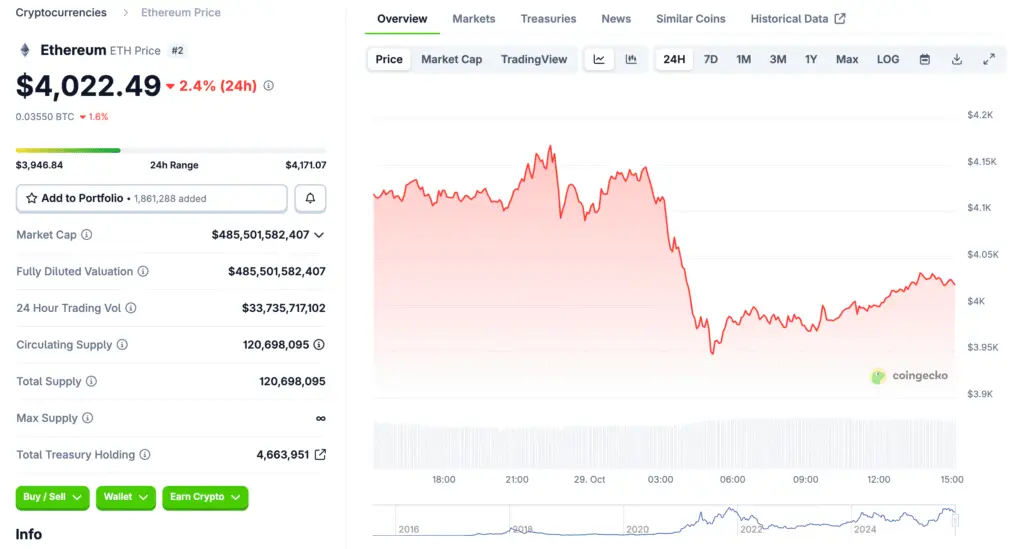Ethereum’s Fusaka Fork Reaches Final Testing Phase
Ethereum’s highly anticipated Fusaka upgrade has successfully completed its final testnet phase, known as Hoodi. Developers confirmed the update will launch on the mainnet by December 3, marking a major step forward in scalability. Nethermind, a leading Ethereum client, announced the test as smooth and stable via its post on X. This milestone reflects continued momentum in Ethereum’s roadmap to greater performance and decentralization.

Key Features of the Fusaka Upgrade
Fusaka integrates several Ethereum Improvement Proposals (EIPs) designed to improve transaction throughput and node efficiency. Among the most significant is EIP-7594, introducing Peer Data Availability Sampling (PeerDAS) for enhanced Layer 2 data handling. The upgrade also raises gas limits and optimizes block validation to streamline user experience. Collectively, these changes prepare Ethereum for parallel execution and broader scalability improvements.
Enhancing Scalability Through PeerDAS Technology
PeerDAS allows validators to verify smaller portions of data from Layer 2 networks rather than entire data blobs. This innovation significantly reduces bandwidth requirements, improving validator participation and overall network decentralization. By increasing node efficiency, Fusaka enhances Ethereum’s resilience and prepares it for mass adoption. It represents a technical evolution aligning with Ethereum’s long-term vision of sustainable growth.
Recommended Article: Ethereum Whales Quietly Accumulate as Market Eyes Major Breakout
EIPs Expand Functionality and Network Efficiency
The Fusaka update includes EIP-7825 and EIP-7935, which collectively enhance gas capacity and processing performance. These proposals support upcoming advances such as parallel transaction execution. They also strengthen Ethereum’s compatibility with zero-knowledge rollups, a crucial component for Layer 2 scaling. The result is a faster, more flexible blockchain optimized for the next wave of decentralized innovation.
Leadership Changes Challenge Ethereum’s Direction
Fusaka’s rollout coincides with notable leadership changes at the Ethereum Foundation. Several prominent contributors have departed, expressing concerns about governance and network priorities. Despite these internal shifts, developer morale remains high following the successful testnet execution. Observers believe this upgrade will reaffirm Ethereum’s dominance even amid increased competition from Solana and Sui.
Ethereum’s Market Performance and Institutional Growth
Ethereum’s price has hit new yearly highs alongside increased inflows into ETFs and corporate treasuries. Institutions continue integrating ETH as a strategic digital asset for yield generation and diversification. This growing adoption reinforces Ethereum’s reputation as a cornerstone of decentralized finance. The momentum around Fusaka’s launch is expected to further support ETH’s value trajectory heading into 2026.
Fusaka’s Three-Stage Implementation Plan
The Fusaka upgrade will roll out in three structured stages to ensure stability and scalability. First comes the mainnet activation, followed by EIPs implementing blob capacity increases. The final phase will involve a secondary hard fork to optimize data handling capacity. These incremental steps ensure that validators and developers can adapt seamlessly to the evolving ecosystem.
Outlook: Ethereum’s Scalability Revolution Continues
Once Fusaka is fully implemented, Ethereum will turn its focus toward the Glamsterdam upgrade under the Surge roadmap. Together, these updates aim to solve the blockchain trilemma by balancing scalability, decentralization, and security. Fusaka marks a critical milestone in achieving that vision and fortifies Ethereum’s global leadership. As scalability expands, Ethereum’s long-term outlook remains decisively bullish for both users and institutional investors.















